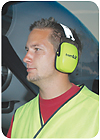
Mergers and acquisitions are commonplace today, as competitors come together to expand their reach globally or complete a product portfolio. Pending regulatory or internal approvals, these new companies face several integration challenges, including consolidating workforces, information technology systems, finance and — just as important — safety programs.
In the two years since America West merged with US Airways to become the number four carrier in the United States, the new US Airways has endeavored to consolidate and enhance its corporate safety program, and specifically its hearing conservation program.
“People are a core value in our safety program,” said Ron Miller, an employee of US Airways, and the Machinists Union ground safety coordinator and chairman of the Labor Division of the National Safety Council. The new organization, said Miller, has taken strides to incorporate its employees in many aspects of the hearing conservation program. “Employees are much more actively involved in the hearing protector device (HPD) selection process and are integrated into the training segment in a unique way,” he said.
While covering all bases of an OSHA-approved hearing conservation program, US Airways adheres to the following best practices in its program.
HPD selection
“The original US Airways started a personal protection equipment (PPE) committee about eight years ago,” Miller said, and it has been maintained through the merger. The PPE committee consists of internal safety professionals, employees, union representatives, purchasing staff and operational managers who all collaborate on product selection and implementation of the hearing conservation program.
In its selection process, the PPE committee evaluates new HPDs with a group of “frontline employees” who work in a variety of departments and geographic locations. These employees are exposed to various levels and types of hazardous noise. The employees are provided with three to five different earplugs, bands or muffs and asked to wear each over an eight-hour shift. Following the trial, each employee completes an evaluation form on each type of HPD, identifying comfort, usability and protection preferences. The PPE committee then reviews the evaluation forms and selects HPDs based on that feedback.
While pricing is a consideration in the decision, it is not always the primary factor. Selection is based primarily on personal comfort and usability. Miller said that while the selected earplug or earmuff may not be the lowest in cost, “if the employees find it comfortable and easy to use, it will be added to our approved product list.” This helps to ensure proper wear and optimal protection.
Audiometric testing
US Airways runs more than 3,600 flights per day, employs over 36,000 employees and maintains a fleet of over 650 aircraft. Needless to say, managing the testing and training component of the airline’s hearing conservation program requires great coordination to ensure efficiency.
All employees exposed to noise, from mechanics to baggage handlers to gate agents, participate in the hearing conservation program. While many employees are exposed to noise at or above 85 dB, John Hazelwood, manager of occupational safety and health, said, “It is more effective to have everyone take part. It improves overall personal safety awareness of the workplace.”
Continuing an America West practice, one-on-one employee training takes place on an annual basis, concurrent with their audiometric testing, Hazelwood said. When employees are tested, they must bring the earplug or earmuff they currently use, and they are asked to don the protector prior to the test. This helps the hearing conservation program specialist to determine if the employee is achieving proper fit, needs additional training, or requires a different HPD. This activity can also help determine if a decrease in hearing may be the result of improper fit.
In the past, US Airways utilized mobile testing services for its annual audiograms at all domestic locations. While this was an effective method for employee audiometry, test vans were only onsite for limited periods of time, and scheduling employees was often disruptive to the overall operation. To increase operational efficiencies, US Airways purchased audiometric test booths and equipment for its larger locations. Trained onsite staff can schedule employees in a more flexible manner and better accommodate active work groups.
Motivational materials
US Airways takes an inclusive approach to its motivation and training materials. To ensure uniformity in both products and wear, large wall posters featuring photos of approved HPDs, ordering information and fitting instructions for each HPD that incorporate images of actual US Airways employees are hung throughout each facility. The airline also utilizes its employees in an internally developed training video that is used to complement its annual one-on-one training. The message hits closer to home when the motivational images reflect the organization’s own people.
Since implementing these approaches, not just for HPDs but for other forms of PPE, Miller said that employee acceptance and proper wear of PPE has increased significantly.
Though the consolidated program has only been in effect for a year, Hazelwood said that the hearing conservation program has been a “good example of how to work together.” It has been one of the first company-wide safety programs to fully unify — successfully merging best practices from both previous programs and innovating where opportunities arose.